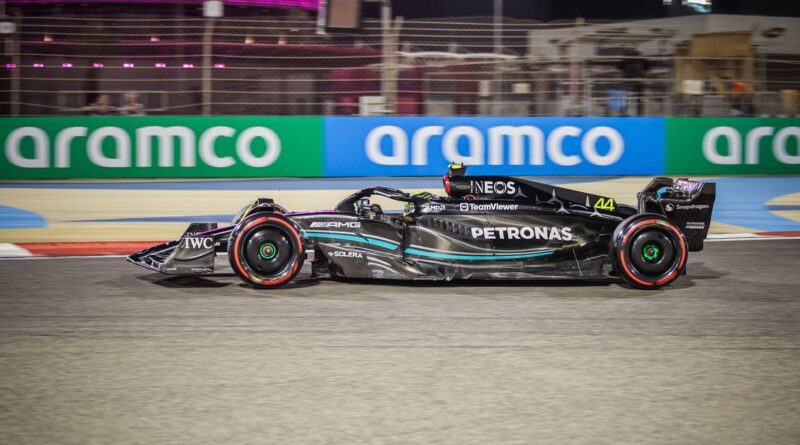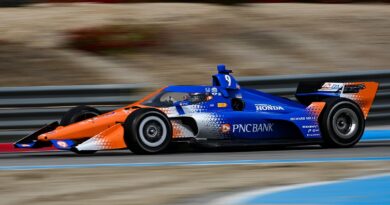F1 2024 pre-season testing, explained
Imagine, if you will, something like this happening in the National Football League.
Following the offseason, all 32 teams congregate in August at the site of the Super Bowl that awaits at the end of the season. Then, over three days before the regular season gets underway the teams participate in a massive session of joint practices. All 32 teams start to figure out what is going to work for them in the year ahead, and what parts of the roster or playbook still need some fine tuning.
All while fans from around the globe watch.
It might sound outlandish, given at a minimum the logistics involved, but something similar is set to unfold in Bahrain.
As the Formula 1 season approaches.
Over three days this week all ten F1 teams will participate in pre-season testing at Bahrain International Circuit, the site of the first race of the 2024 F1 season. They will put their respective challengers for the upcoming schedule through the paces and find out what is working, and what needs to be fixed.
Then they will do it all for real the following week.
Here is what to expect from F1 pre-season testing.
What is pre-season testing?
Let’s start with a basic question.
What is pre-season testing?
Pre-season testing is a three-day event at the Bahrain International Circuit, site of the season-opening Grand Prix a week later. Over three days this week (Wednesday, Thursday, and Friday) teams are allowed to put their cars on the track with minimal restrictions, to get a sense of how their setups, and aerodynamics, will look for the season ahead.
Each day is broken up into two sessions, a morning session which starts at 10:00 a.m. local time and runs for four hours, and an afternoon session which starts at 3:00 p.m. local time and runs for four-and-a-half hours. The importance of that afternoon session is that it will last beyond sunset, allowing teams to get a feel for how the cars will run during night-time conditions.
That will come in handy the following week, as the Bahrain Grand Prix is run at night.
Teams can approach these sessions in a number of different ways, but the main goal is to iron out any major issues, hone setups, and make adjustments as necessary. Teams can also isolate what areas of their cars need to be upgraded ahead of the season, which begins just over a week later.
When is it being held?
Pre-season testing is set to begin on Wednesday, February 21, and will run three days as noted above. Each day consists of two sessions, a morning session that begins at 10:00 a.m. local time, and an afternoon session that begins at 3:00 p.m. local time.
Wednesday
Morning session: 10:00 a.m. local time / 2:00 a.m. Eastern
Afternoon session: 3:00 p.m. local time / 7:00 a.m. Eastern
Thursday
Morning session: 10:00 a.m. local time / 2:00 a.m. Eastern
Afternoon session: 3:00 p.m. local time / 7:00 a.m. Eastern
Friday
Morning session: 10:00 a.m. local time / 2:00 a.m. Eastern
Afternoon session: 3:00 p.m. local time / 7:00 a.m. Eastern
Why is it held in Bahrain?
Two reasons, really. The first reason is logistical. With the season beginning at the same track the following week, that cuts down on the travel time for each team. That also helps support F1’s sustainability goals.
The second is the layout of the Bahrain International Circuit, which you can see here in a diagram from F1.com:
The design of Bahrain International Circuit allows teams to test their cars under a few different conditions. There are some long straights — including the very long straight coming out of Sector 3, through the start/finish line and into Sector 1 — and some tight corners, most notably in Sector 2.
This layout means teams will be able to test out how their cars handle both long straights, as well as tight corners.
How are tires handled?
Pirelli, the tire provider for F1, provides all teams an equal number of each tire compound. This allows the teams to complete as many laps as they wish with each tire compound. This allows teams to get a sense of pit strategy for when the season begins.
Back in December Pirelli announced that all five tire compounds available to the teams this season — ranging hard-to-soft from the C1 to the C5 — will be available for the teams during pre-season testing.
Are their specific things teams can or cannot do during testing?
Testing is not held under grand prix conditions, and while normal safety requirements must be followed, teams are permitted to design their own testing programs. That includes selecting which drivers are going to participate, including reserve and/or testing drivers who are not slated to compete in the upcoming season.
I am seeing neon paint on some of the cars. What is that?
In F1, aerodynamics is everything. How well air flows — or does not flow — over the car can mean the difference between a podium finish, and a finish outside the points.
So finding out how the air is flowing over the cars is a huge part of the process, including during testing.
To get a clearer picture of how air is flowing over different parts of the car, teams will use what is called “flow-vis” paint. This is a paint composed of a fluorescent powder mixed with a light oil, applied to the front of the car before it takes to the track. As the car works through the circuit, the paint flows over the car, following the air.
Photo by Bradley Collyer/PA Images via Getty Images
In the above photograph taken from pre-season testing ahead of the 2022 season, you can see the flow-vis paint on the Williams Racing car driven by Nicholas Latifi.
Do not be surprised if, when watching pre-season testing, teams try and hide the results of a run using flow-vis paint. Often when the cars return to the garage after a run with flow-vis paint, teams cover the car so their competitors cannot get a sense of what is working … and what is not.
Why does it look like some of these cars have driven through a fence?
The flow-vis paint discussed above is not the only method teams use to gather data on the track during testing.
Allow us to introduce “aero rakes.”
Aerodynamic rakes, or “aero rakes” for short, are another means of gathering data on the cars in near real-time. These are ‘pitot tubes’, which are sensors designed to measure off-body air flow. These can be placed on various parts of the car, to measure how air is flowing over various parts. For example, if you wanted to see how the air was flowing over the front win, you can place the aero rake behind the front tires. If you wanted to see how air was flowing over the entire car, you can place the aero rake on the rear of the car, as you can see in this example from Ferrari during 2017 testing:
Photo by Charles Coates/Getty Images
This image from testing in 2022, with a massive aero rake fitted to the AlphaTauri of Pierre Gasly, gives you a sense of how big they can be:
Photo by Bradley Collyer/PA Images via Getty Images
So if you see these on the track this week, do not worry. Someone has not taken a wild wrong turn, instead it is another means of their teams gathering data on the car.
Are these the final cars that teams will use this season?
Adapt or die is part of life in F1. Teams are constantly looking to upgrade their cars, looking to squeeze every last bit of power out of them, and shave of every possible millisecond.
To that end, while the cars we will see this week are close to the final product, the results of testing often force some upgrades. A prime example comes to us from McLaren a season ago. During pre-season testing in 2023, it became clear that the MCL60 needed some upgrades.
The team rolled those out over the course of the season, and while they were fighting for points at the start of the year — as Lando Norris explained to me ahead of the Azerbaijan Grand Prix — they were fighting for podiums and wins by season’s end.
How much should we read into the lap times this week?
In reality? Not much. Given the number of variables at work — teams are trying different programs, with different tyre compounds and different fuel loads — it is usually hard to get a clear sense of how the grid stacks up before the season begins. Remember, while all the tyre compounds are available during testing, once the season begins, Pirelli allocated just three of the five different dry-weather tyre compounds for each Grand Prix. So we might see a team this week put down a fast lap time on a tyre compound that is not going to be in use next week during the Bahrain Grand Prix.
Also, teams do try and hide just how strong they are during testing, saving their full performance capability during the first qualifying session of the season. This is a tactic referred to as “sandbagging.”
Still, in recent history we have seen teams strong during testing come out and secure the pole position at the same track during the season. In 2021 Max Verstappen of Red Bull posted the fastest lap time during testing, and secured the pole at the Bahrain Grand Prix later in the season. In 2020 Valtteri Bottas of Mercedes posted the fastest lap time during testing, and his teammate Lewis Hamilton qualified on pole at the Spanish Grand Prix later that year. That season testing was held in Barcelona.
What we can mainly ascertain is what teams are going to start the season on the front foot, and what teams will begin the year with some work to do. Take last season. During pre-season testing a year ago it was clear that Red Bull’s RB19 was going to be strong, and that proved to be true as Red Bull won all but one grand prix a season ago, and Max Verstappen lapped the field in the Drivers’ Championship.
But we also learned that Aston Martin had something cooking with the AMR23, and they began the year on the front foot and were in second place behind Red Bull during the early going. We also got our first glimpses of what Williams was going to bring to the table, as they delivered a promising seventh-place finish in the Constructors’ Championship.
We also learned that McLaren had some work to do with the MCL60. They left Bahrain promising some future upgrades to their challenger, which they slowly rolled out over the course of the 2023 season. While they indeed started on their heels, they made a mid-season charge up the table, to finish in a stunning P4 in the Constructors’ Championship.
So in many ways, pre-season testing will tell us who is on solid footing to begin the year, and who has some work ahead of them.
Is there a winner?
As with anything in F1, times will be kept.
But you should, as noted, take them with a pinch of salt.
Teams will be running different programs, using different setups and tire compounds, and using reserve drivers as well. So while each session will see a driver post the fastest lap time, you cannot immediately assume that that team/driver pairing will see that success continue into the season-opening Bahrain Grand Prix.
(Although, the past few years have seen Verstappen top the timing sheets so maybe there will be some truth in the numbers).
In addition, just because a team completes a lot of laps (or conversely the fewest amount of laps) does not mean that they are either going to be consistent over the season, or struggle with reliability issues on the other end of the scale. Last year AlphaTauri (now VCARB) posted the most laps during pre-season testing, while McLaren posted the fewest.
McLaren found a way to charge through the field over the second half of the season for a fourth-place finish in the Constructors’ Championship.
What drivers are testing, and when?
Teams are starting to announce which drivers are running during which sessions. So if you have a favorite driver, you might want to check back as this will be updated. As of the time of publication, Haas is the only team that has announced their schedule.
Days and drivers
Wednesday am: Kevin Magnussen, Verstappen
Wednesday pm: Nico Hülkenberg, Verstappen
Thursday am: Hülkenberg, Sergio Pérez
Thursday pm: Magnussen, Verstappen
Friday am: Magnussen, Pérez
Friday pm: Hülkenberg, Pérez
Schedule by team:
Haas:
Wednesday: Magnussen (morning), Hülkenberg (afternoon)
Thursday: Hülkenberg (morning), Magnussen (afternoon)
Friday: Magnussen (morning), Hülkenberg (afternoon)
Red Bull:
Wednesday: Verstappen (all day)
Thursday: Pérez (morning), Verstappen (afternoon)
Friday: Pérez (all day)
Can I watch pre-season testing?
That depends on where you are reading this from, dear reader.
For those joining us from the United Kingdom and Ireland, Sky Sports F1 will broadcast the entirety of F1 testing.
Those outside of the United Kingdom and Ireland will be able to watch testing via F1TV, F1’s streaming service.
This post will be updated as driver and team schedules are announced.



